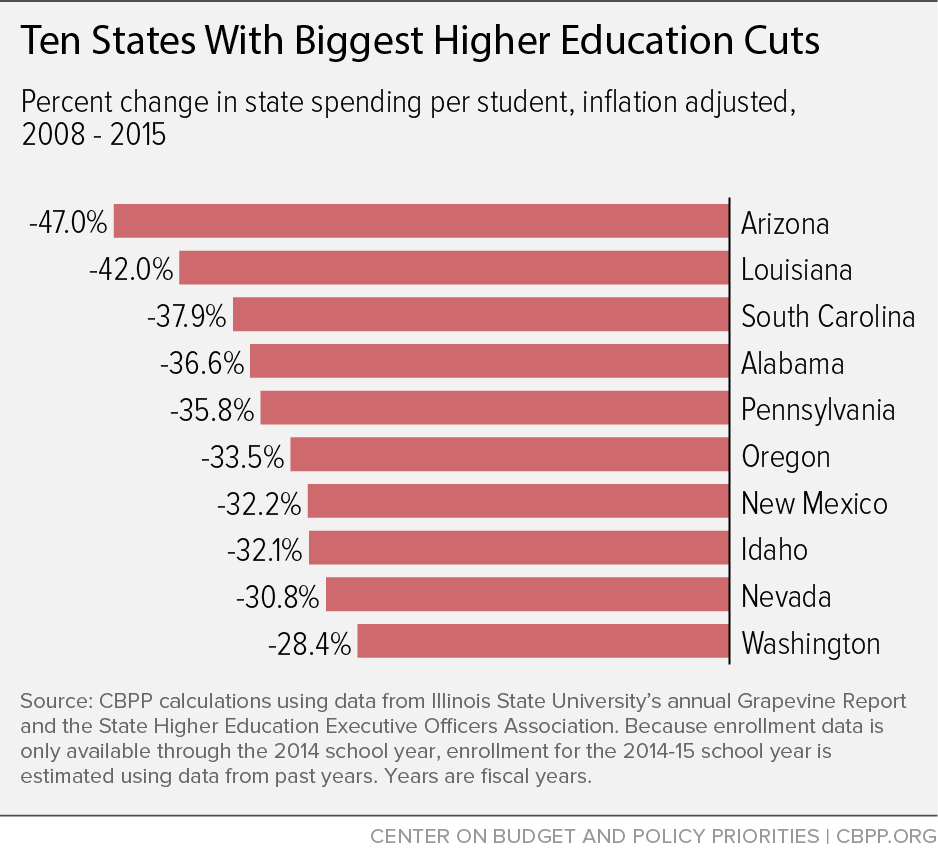Years of Cuts Threaten to Put College Out of Reach for More Students
Quality, Affordable Colleges and Universities Key to States’ Workforces and Economies
Higher education funding remains well below pre-recession levels in almost all states, a new CBPP report shows. Although the majority of states have begun restoring funding to their higher education systems, 47 states are spending less per student today than they did before the recession.
As a result, public colleges and universities have had to raise tuition and make spending cuts that may diminish the quality of education available to students at a time when a highly educated workforce is more crucial than ever for economic growth and vitality.
Thirteen states cut per-student higher education funding further this year even as the economy recovers and revenues have returned to pre-recession levels, the report found. Three of these states — Kentucky, Oklahoma, and West Virginia — have cut funding the last two consecutive years.
“College-educated workers are essential to our nation’s economic success,” said Michael Mitchell, policy analyst at the Center on Budget and Policy Priorities and author of the report. “States must reinvest in their colleges and universities now to build the workforce they need to compete in decades to come.”
The average state is spending $1,805, or 20 percent, less per student than it did in 2008. And in five states — Alabama, Arizona, Louisiana, Pennsylvania, and South Carolina — per-student funding is down by more than 35 percent. While 37 states increased funding in the last year, the increases were very modest, with states increasing per student spending by 3.9 percent nationally.
Deep Cuts Have Had Major Consequences for Schools and Students
To make up for this declining state investment, public colleges and universities across the country have increased tuition considerably. Annual published tuition at four-year public colleges has risen by $2,068, or 29 percent, since the 2007-08 school year, after adjusting for inflation. In Arizona, published tuition at four-year schools is up more than 80 percent, while in five other states — California, Florida, Georgia, Hawaii, and Louisiana — it’s up more than 60 percent.
These sharp increases in tuition have accelerated longer-term trends that have made college less affordable and shifted costs from states to students and their families. Federal student aid and tax credits have risen, but on average they have fallen short of covering the tuition increases. As a result, student debt levels have swelled since the start of the recession. Students now hold $1.16 trillion in student debt.
“High levels of student debt are a major problem for low- and modest-income families and rapidly rising tuition is scaring some students away from enrolling in college altogether,” said Mitchell. “States can help keep college accessible to low-income and middle class students by re-investing in public colleges and universities.”
Tuition increases have compensated for only part of the revenue loss resulting from state funding cuts. Public colleges and universities have cut faculty positions, eliminated course offerings, closed campuses, shut computer labs, and reduced library services, among other cuts. For example, the 14 state-owned universities within the Pennsylvania State System of Higher Education eliminated 95 academic programs between 2011 and 2014.
States’ Budget Choices Will Determine Whether They Can Successfully Rebuild Their Higher Education Systems, Strengthen Economies in Long Run
A large and growing share of future jobs will require college-educated workers. Sufficient funding for higher education to keep tuition affordable and quality high at public colleges and universities, and to provide financial aid to those students who need it most, would help states develop the skilled and diverse workforce they will need to compete for these jobs.
Such funding will be difficult to come by if states choose to cut taxes rather than devote revenue to their higher education systems.
“To ensure that public colleges and universities are a place where middle-class and low-income students can receive a high-quality and affordable education, states need to reject costly tax cuts,” said Mitchell. “Some may need to consider options for new revenues.”
The full report, Years of Cuts Threaten to Put College Out of Reach for More Students, is available at https://www.cbpp.org/research/state-budget-and-tax/years-of-cuts-threaten-to-put-college-out-of-reach-for-more-students.
The Center on Budget and Policy Priorities is a nonprofit, nonpartisan research organization and policy institute that conducts research and analysis on a range of government policies and programs. It is supported primarily by foundation grants.
